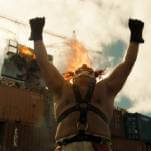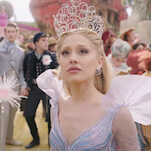Animator Fred Wolf has had a steady career in TV animation for years. Between the mid-’80s and the late ’90s, Wolf worked on shows such as Teenage Mutant Ninja Turtles and Ducktales—cartoons that spread across the quality spectrum, from genuinely great to utterly abysmal. Wolf worked on various animated films since the ’60s, too, but there’s a reason his earlier movies have been more or less completely forgotten about, as they were generally more awful than even the worst episodes of The Littles. In 1986, Wolf, along with director Nobutaka Nishizawa and writer Norm Lenzer, produced the film The Adventures Of The American Rabbit, a bizarre, woeful Cold War allegory in which a teenage rabbit gains the ability to transform in an “American-flag clad” Superman who’s wearing roller skates for some reason.
Nishizawa was a prolific TV animation director, working on several one-season anime programs from the 1980s. Lenzer was less prolific and seems to have only scripted two TV movies and an episode of The Man From U.N.C.L.E. The circumstances that brought Wolf, Nishizawa, and Lenzer together on a low-budget animated film—produced and distributed through three countries (the U.S., the U.K., and Japan)—are a mystery, but the film’s character designs were based on the work by pop artist Stewart Moskowitz, whose work was made into mascots by several Japanese companies (according to the wiki, at least). So it’s reasonable to assume that part of the reasons this film was made was similar to most 1980s animated entertainment: merchandising opportunities.
The Adventures Of The American Rabbit tries to surpass its “toyetic” roots by pitting its jingoist hare up against a villainous jackal gang. Despite its ridiculous opening, in which Rob gains his powers magically and with the help of the creepiest wizard ever, there’s actually a low-key, hokey charm to Rob’s piano audition with Teddy and uncomfortably over-sexed rabbit Bunnie O’Hare. The early “protection racket” plot is bizarrely portrayed, but it’s still a pretty standard story to work with.
But once they introduce the film’s big bad—a faceless, suit-wearing fatso who runs the jackal gang—the film quickly goes off the rails, bogged down with way too many ill-conceived plot contrivances and nonsensical moments, terrible even by the low standards of the time. It’s hard to know what’s dumber: the decision to go river-rafting down the Grand Canyon to find a jazz club, talking to a music company to “rent out” the Statue Of Liberty, or controlling the citizenry by taking over the world’s chocolate. And, yes, these are real plot points.
More to the point, The Adventure Of the American Rabbit’s neo-conservative ideology comes off both ugly and perplexing, even in the backdrop of the U.S./Soviet conflict. Rob is the ideal American: athletically perfect yet humble, brilliant and musically talented, considerate and kind. Of course he’s given the “legacy” of the American Rabbit, whose role is to “work tirelessly to make the outside world a better, happier place.” (The use of the word “outside” is particularly suspect.) The outsiders include the jackals, a bunch of moronic henchmen who rock generic ’50s motorcycle gear with obvious Nazi flair: kaiser helmets, distinct armbands, and an Vulture-supporting patches. At its most confusing, there’s a lot of lazy discussion among the “good characters” over how jackals aren’t all bad, despite the film showing nothing but bad jackals. It’s the kind of back-handed nonsense that attempts to assert America’s Christian tolerance while not actually applying to any single character. It’s everything that Zootopia specifically called out.
The major twist is the film’s final Cold War allegory in the hole—the fatso is actually controlled by the vulture on his shoulder, whose claws are literally on the switch that could lead to city-wide annihilation. It’s a concept that’s emphasized as the American Rabbit chases the vulture into a cold, wintery storm, unfazed by the vulture’s global-takeover, sharing-economy plan. The American Rabbit would never make a deal with such evil, but he doesn’t even get the satisfaction of stopping him; instead the Vulture kills himself after an ill-advised kamikaze dive. It’s an idiotic scene in a film filled with them—a cluttered mess of an metaphor that makes Care Bears Movie II: A New Generation look brilliant. At least that film had a genuinely great ending sequence.







































